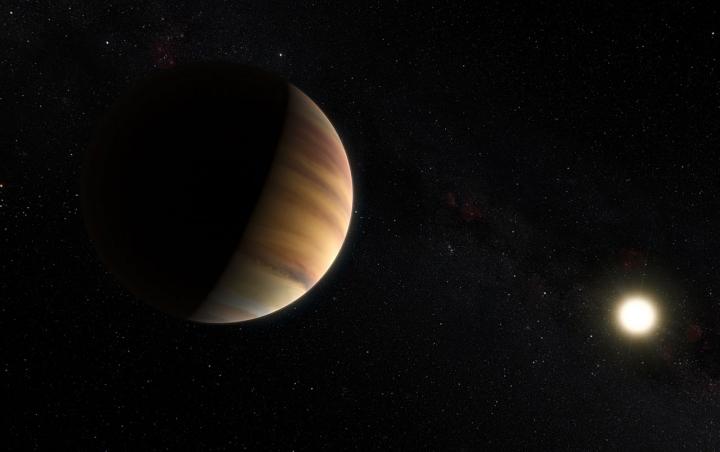51 Pegasi b, about 50 light-years from Earth in the constellation of Pegasus, was discovered in 1995 and was the the first confirmed exoplanet to be found orbiting an ordinary star like our Sun. It is the archetypal Hot Jupiter -- a class of planets similar in size and mass to Jupiter but orbiting much closer to their parent stars.
Since that landmark discovery, more than 1,900 exoplanets in 1,200 planetary systems have been confirmed, but 51 Pegasi b now has another "first" - it has been directly detected in visible light.
The commonly used method to examine an exoplanet's atmosphere is to observe the host star's spectrum as it is filtered through the planet's atmosphere during transit -- a technique known as transmission spectroscopy. An alternative approach is to observe the system when the star passes in front of the planet, which primarily provides information about the exoplanet's temperature. The new technique does not depend on finding a planetary transit, and so can potentially be used to study many more exoplanets.
The host star's spectrum is used as a template to guide a search for a similar signature of light that is expected to be reflected off the planet as it describes its orbit. This is an exceedingly difficult task as planets are incredibly dim in comparison to their dazzling parent stars.

Artist's view shows the hot Jupiter exoplanet 51 Pegasi b, sometimes referred to as Bellerophon, which orbits a star about 50 light-years from Earth. Credit: ESO/M. Kornmesser/Nick Risinger (skysurvey.org)
The signal from the planet is also easily swamped by other tiny effects and sources of noise. 51 Pegasi b was found to have a mass about half that of Jupiter's and an orbit with an inclination of about nine degrees to the direction to the Earth. The planet also seems to be larger than Jupiter in diameter and to be highly reflective. These are typical properties for a hot Jupiter that is very close to its parent star and exposed to intense starlight.
The team that made this new detection was led by Jorge Martins from the Instituto de Astrofísica e Ciências do Espaço (IA) and the Universidade do Porto, Portugal, who is currently a PhD student at ESO in Chile. They used the HARPS instrument on the ESO 3.6-metre telescope at the La Silla Observatory in Chile.
Jorge Martins explains: "This type of detection technique is of great scientific importance, as it allows us to measure the planet's realmass and orbital inclination, which is essential to more fully understand the system. It also allows us to estimate the planet's reflectivity, or albedo, which can be used to infer the composition of both the planet's surface and atmosphere."
Citation: "Evidence for a spectroscopic direct detection of reflected light from 51 Peg b", by J. Martins et al., to appear in the journal Astronomy&Astrophysics on 22 April 2015. The team is composed of J. H. C. Martins (IA and Universidade do Porto, Porto, Portugal; ESO, Santiago, Chile), N. C. Santos (IA and Universidade do Porto), P. Figueira (IA and Universidade do Porto), J. P. Faria (IA and Universidade do Porto), M. Montalto (IA and Universidade do Porto), I. Boisse (Aix Marseille Université, Marseille, France), D. Ehrenreich (Observatoire de Genève, Geneva, Switzerland), C. Lovis (Observatoire de Genève), M. Mayor (Observatoire de Genève), C. Melo (ESO, Santiago, Chile), F. Pepe (Observatoire de Genève), S. G. Sousa (IA and Universidade do Porto), S. Udry (Observatoire de Genève) and D. Cunha (IA and Universidade do Porto).






Comments